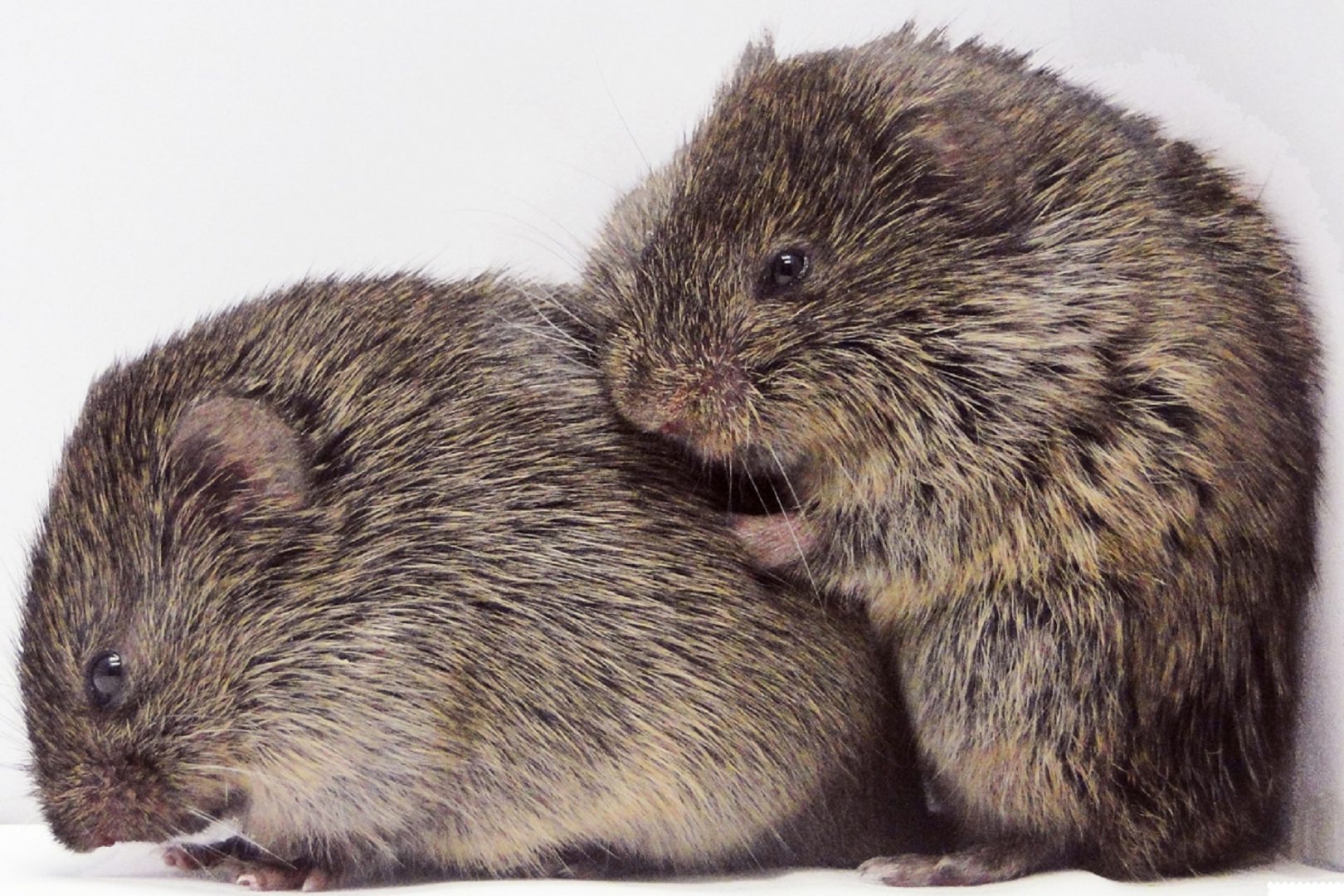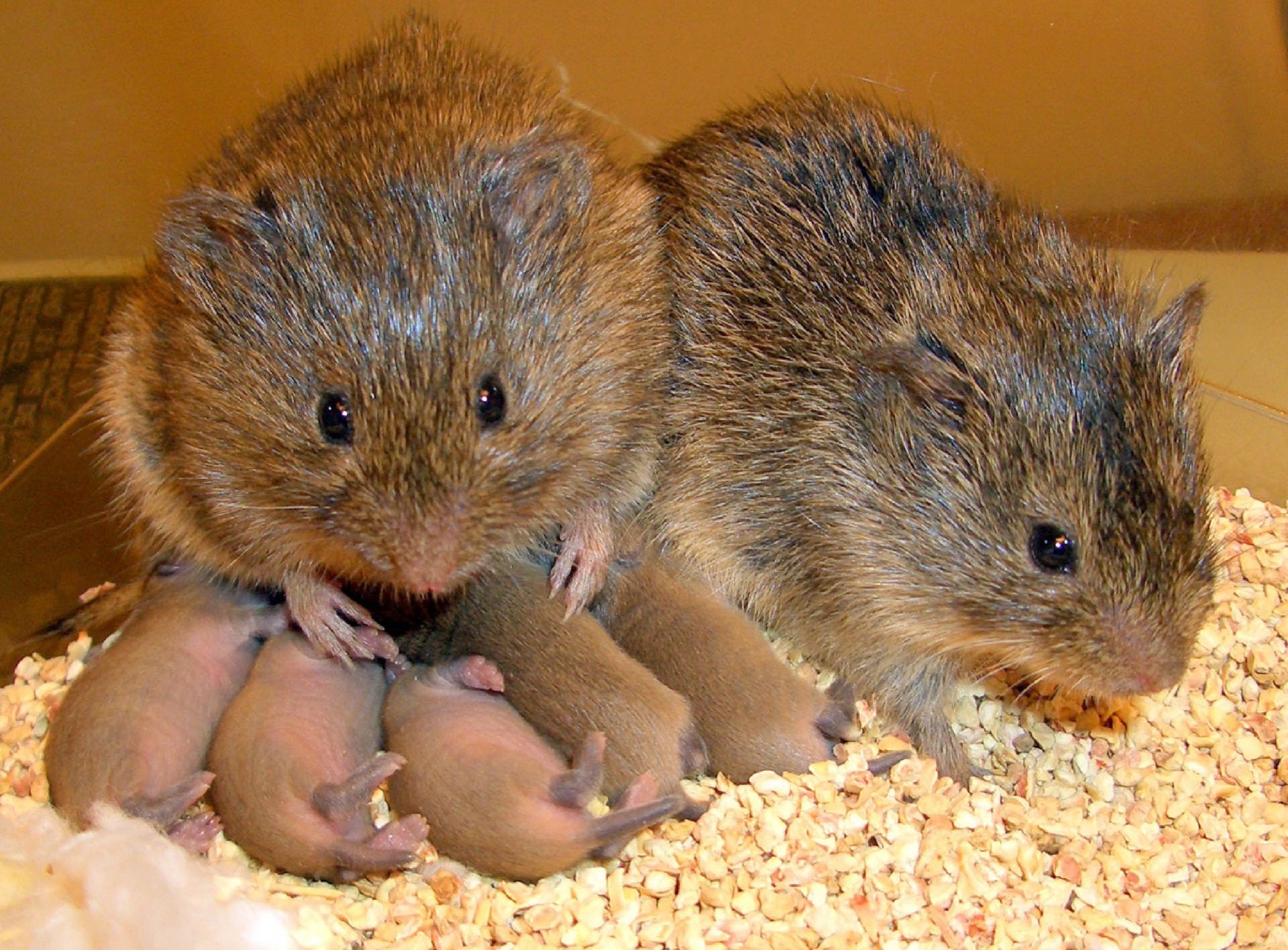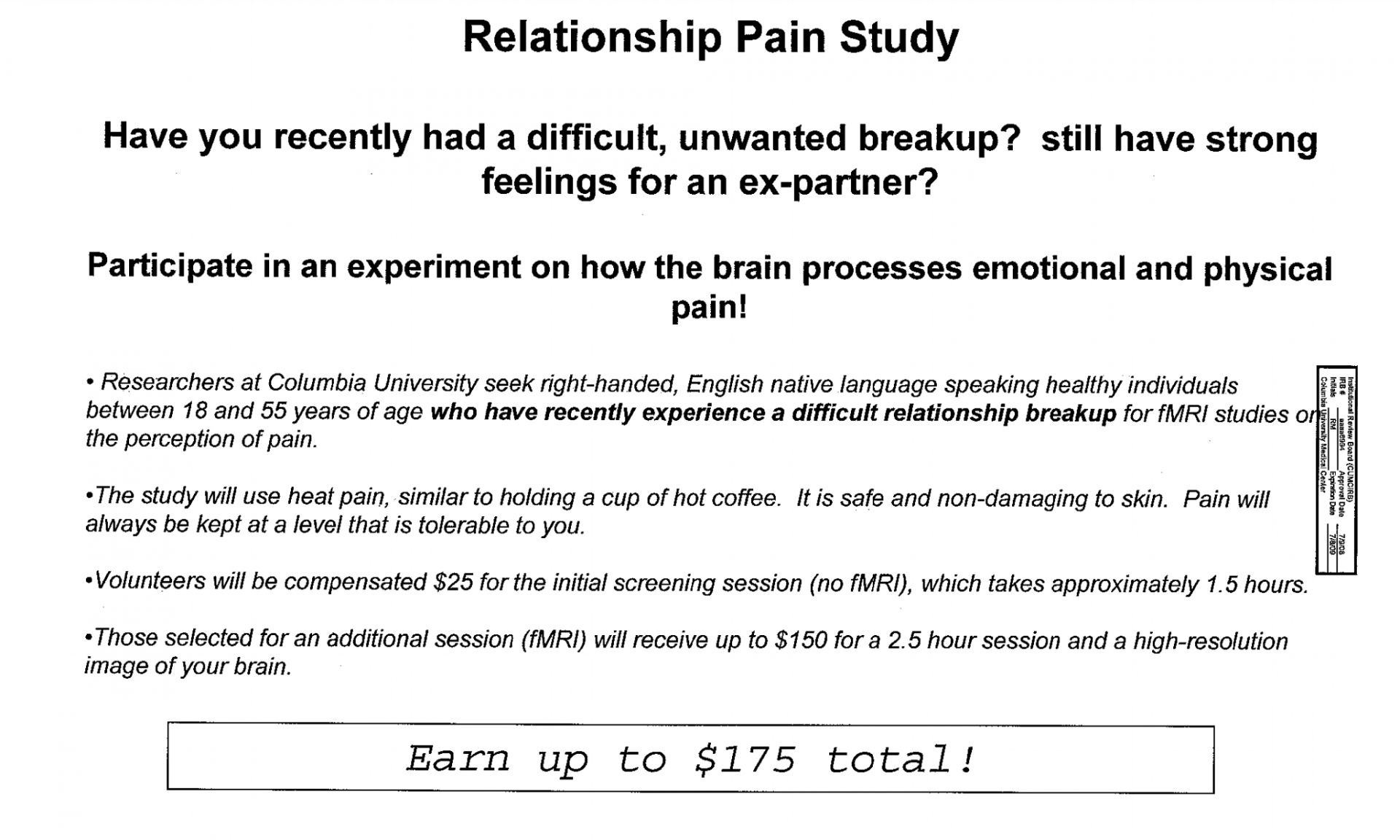
“Heartbroken” voles get over their ex's with a shot of oxytocin. It's not so simple in humans, but researchers find you can ease the ache.
Courtesy of Larry Young

“Heartbroken” voles get over their ex's with a shot of oxytocin. It's not so simple in humans, but researchers find you can ease the ache.
Courtesy of Larry Young

Courtesy of Larry Young
“Heartbroken” voles get over their ex's with a shot of oxytocin. It's not so simple in humans, but researchers find you can ease the ache.
You can learn a lot about love and heartbreak from voles. They look a bit like a cross between a mouse and a hamster. And they’re monogamous. Most animals are not.
“In mammals, only about 5% of species formed these long-term bonds,” said Larry Young, an Emory University researcher. “It’s kind of rare.”
Young has studied voles in the lab to understand the neurobiology behind social behavior. Voles have something like love, and it’s very cute.
“Within a day after they mate, they then prefer to spend their time just sitting next to each other, touching each other — what we call ‘huddling,’” he said. “So just sitting next to each other, facing in the same direction, and perfectly still.”
Their version of heartbreak is also kind of cute, but also desperately sad.
“A vole that has been with a partner and then you take the partner away, if you put them in a beaker of water for a few minutes, they tend to just float,” he said. “If you hold them up by their tail, they just hang there. They show the signs of despair.”
They just give up on life — basically, it’s not worth it without her.
But for voles at least, there is a cure for a broken heart: oxytocin. It’s a naturally occurring hormone.
“If at the moment that the partner goes away, we infuse a little bit of oxytocin into the brain, it’s as if they’ve never lost their partner at all,” Young said. Back to care-free bachelor voles.
Lots of mammals produce oxytocin, including humans.
“When a mother is getting ready to have birth, her brain releases oxytocin,” he said. “It goes to the uterus, the uterus begins to contract.”
Then, after delivery, the same oxytocin boosts the salience of the mother’s perception of her newborn. It’s like taking a fuzzy TV signal and turning it to 4k.
“And that causes the brain to pay very close attention to the details, the smells, the face, all the different little attributes of the baby,” Young said.
It’s all brilliant and beautiful. Even the ugliest babies are beautiful in their mothers’ eyes — they bond. And the same oxytocin hormone is produced by dad, as well.
“In a few species that have evolved monogamy or this pair bonding, the same molecule that is causing other mothers to bond with their babies [is] now causing the parents to bond with each other,” Young said.

Courtesy Larry Young
A family of voles.
Oxytocin is first of three chemicals that essentially create love. There’s also dopamine — the feel-good, cocaine-y neurotransmitter — and vasopressin, another hormone. In animals like voles and humans that form monogamous bonds, these three have matching receptors in the addiction centers of the brain.
Those depressed, floating voles, the ones hanging listlessly by their tails, they’re in withdrawal. It’s because of the stress hormone, CRF.
“It really gets loaded when the animals form a bond. But it’s not released. It’s just loaded, like loading a gun,” Young said. “But then when they are away from their partner, that CRF floods into the brain.”
And CRF stops oxytocin production cold. Young thinks it’s maybe a naturally evolved kind of insurance policy. Animal partners, voles and humans, have to spend some time apart to forage seeds or go to class or whatever. That CRF is part of what bums you out, makes you miss the other person, and go back to them to get another fix of oxytocin.
“Just like a heroin junkie or a cocaine junkie, when they go without their drug for a little while, they get a negative effect that brings them back to the drug,” said Young.
So in voles, you can replace the drug, infuse oxytocin into the brain, and they’re fine. But for humans, that doesn’t really work — it’s a more complicated problem. It’s why Young is careful to say bonds or bonding when talking voles. He doesn’t call what they have love.
“I think that love probably is fairly uniquely human,” Young said. “It’s [because of] our cortical capacity, our intellectual capacity. Not only to feel that strong drive, but to really speak the language of romance, [and] to think about the future, to think about abstract things.”
Other animals experience the addiction, the drive of bonding, while humans make it into what Young calls love by applying meaning to it. And we apply meaning to heartbreak, too.
“We are uniquely equipped to replay and ruminate on negative feelings over and over and over again,” said Ethan Kross, who runs the Emotion and Self Control Lab at the University of Michigan.
“This process of turning over in your mind over and over and over again, that negative experience, that can become a toxic process,” he said.
Rumination has real health impacts — everything from cardiovascular health to aging — because it’s essentially chronic stress.
“This really is how stress gets under the skin and hurts us,” Kross said. “A stress reaction isn’t bad per se, it’s when we are experiencing stress chronically over and over and over and over again.”
Kross said heartbreak is a uniquely insidious stress response because it invites that replaying of events: If only I’d said this instead of that. I should have seen this sign or that.
So to study heartbreak, Kross and his team designed an experiment that’s kind of messed up.
“I should preface all of this to say that it, you know, sounds like we were torturing people, [but] we’re doing this stuff to learn more about how emotions and pain works to ultimately help people,” he said.
He put up posters all over New York City — “Seeking heartbroken individuals for brain study” — and quickly found 40 some participants.

A flier seeking heart broken individuals for brain study
“On the whole, they were quite jovial until they participate in the task, and that’s where things turned a little bit less jovial,” Kross said.
The task: Look at pictures of your ex. Think about them, think about the breakup.
“So how did you feel in the precise moment where this other person told you they no longer want to be in a relationship with you?” Kross would ask.
That all happened as the team scanned each participants brains and applied thermodes to their skin. A thermode is basically a piece of metal that you can heat up electrically.
“The sensation is akin to holding a hot cup of coffee … without the that protective sleeve,” Kross said.
It hurts, but it doesn’t harm you. They saw activity in a certain brain region with both the hot metal and the ex’s Instagram.
“So if I pinch you, these parts of your brain become active. They’re registering physical pain,” Kross said. “Those were also active when people were experiencing social pain, thinking about a broken relationship.”
Love hurts, he found — physically.
That was in 2011. Over the years, Kross and his lab has found a few ways to make it hurt less. Up first, there’s mental time travel.
“So, telling people to imagine how they would feel in a year from now rather than think about how they feel right now,” Kross said. “That in itself is a little mental hack, if you will, psychological hack that can help improve the way people feel. It’s called temporal distancing.”
Another strategy is to talk about the breakup like it’s happening to someone else, not you. Which kind of makes sense: Other people’s breakups always seem kind of melodramatic. Kross said it’s easy to think that way when it’s not your breakup — you didn’t suffer what he calls the emotional assault.
“When we experienced those kinds of traumas or assaults — and assault isn’t a bad way to think about it, an emotional assault — our attention narrows. So we devote our resources on a problem,” Kross said. “Just like if we were going to battle and someone attacked us, we would devote all of our forces towards warding off that attack. Our attention zooms in, narrows on that experience.”
You get stuck in this attacked experience — Kross calls it immersion. So you can’t see, for instance, that’s there are plenty of fish in the sea.
He hopes his research helps shift how we think about social pain like heartbreak.
Guy Winch, a psychologist in Manhattan, said therapists don’t know enough about healing a broken heart.
“When I asked therapists, ‘How many of you got any training whatsoever on this condition and what to do about it?’ No one did. And I didn’t either,” Winch said, the condition being heartbreak. “It’s just not something we cover in schools, even though it’s extremely common and extremely traumatic.”
Winch has been working on filling that gap — he wrote a book about it called, “How to Fix a Broken Heart.” He dove into the literature, looked for research like Kross’ and others’, anything that touched on heartbreak.
He learned about the physical pain of it and the ways it resembles and works like addiction. And to him, heartbreak also seemed quite a lot like grief.
“Just in terms of what it looks like phenomenologically, it’s a form of grief,” Winch said. “It’s what you see in other forms of grief and loss, whether you’re losing a relative or a spouse or a partner.”
Winch calls heartbreak a kind of disenfranchised grief. Even though it’s like a loved one dying, even though it works like addiction, even though it physically hurts, we don’t take it seriously.
“It’s not something when, if you have a relationship with somebody for three years but you’re not married and you’re a 40-year-old executive, you’re going into work and saying to your boss, ‘I need a couple of days off, my boyfriend left me,’” Winch said. “It’s just not a career move you would make, and yet you might not be able to function at all.”
Part of the cure for a broken heart, he said, is taking heartbreak seriously. He tells patients they’re not crazy when considering a cross-country, last-ditch mission to get her back — they’re in the throws of addiction. That they’re not acting like angsty teens when they can’t go into the office without crying — they’re grieving.
He tells them this will pass, they’ll find someone else, someone just as good — probably better.
“In other words, you’re not grieving Mr. or Mrs. Perfect, you’re not grieving the perfect relationship that was happiness in place from morning till night, because that doesn’t exist,” Winch said. “Certainly, if that was the case, then there wouldn’t have been a breakup.”
Larry Young, the researcher who cures vole heartbreak with oxytocin infusion, he told me finding someone else, a new Mr. or Mrs. Perfect, is probably the best cure for humans.
The old rebound.
“Identify another partner that is going to start the whole process over again of releasing dopamine and oxytocin, and that’s going to help sort of rewrite those neural circuits,” Young said.
He knows from experience. After his first marriage fell apart, he was like one of his voles, floating listlessly in a beaker, too sad to swim.
“I was devastated,” Young said. “I lived in a house with no furniture. I had like a lawn chair and a $25 television set and, yeah, I was devastated.”
Then, enter her.
“She studied the neural circuitry of male sexual behavior in rats,” Young said.
He studied vole mating, she studied rat mating, it was a typical will they/won’t they. They met at a conference in Italy.
“It was just a romantic kind of thing,” Young said. “Capri, a small little Island, you know? And there’s all these things, there’s the blue grotto and all these beaches with nice rocks and everything.”
The two of them pair-bonded one night, as Young put it, and they’ve been happily married since 2004.

Get insights into WITF’s newsroom and an invitation to join in the pursuit of trustworthy journalism.
The days of journalism’s one-way street of simply producing stories for the public have long been over. Now, it’s time to find better ways to interact with you and ensure we meet your high standards of what a credible media organization should be.